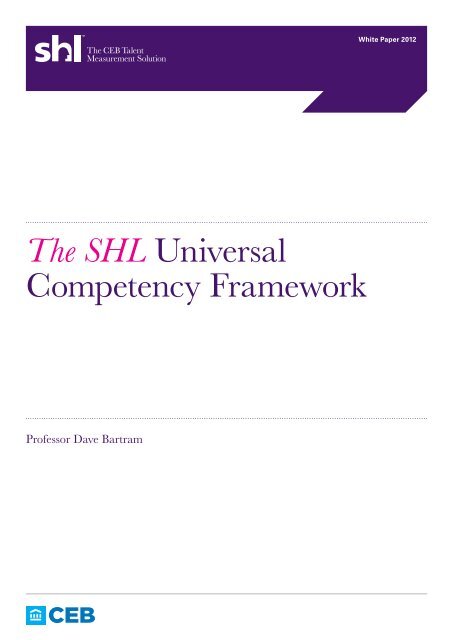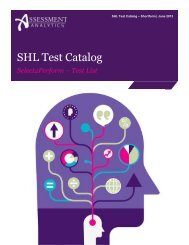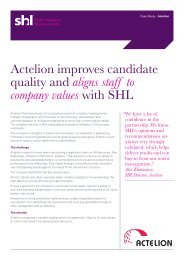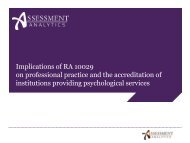White Paper - The SHL Universal Competency Framework
White Paper - The SHL Universal Competency Framework
White Paper - The SHL Universal Competency Framework
Create successful ePaper yourself
Turn your PDF publications into a flip-book with our unique Google optimized e-Paper software.
<strong>White</strong> <strong>Paper</strong> 2012<strong>The</strong> <strong>SHL</strong> <strong>Universal</strong><strong>Competency</strong> <strong>Framework</strong>Professor Dave Bartram
shl.com<strong>White</strong> <strong>Paper</strong> | <strong>Universal</strong> <strong>Competency</strong> <strong>Framework</strong>Summary<strong>The</strong> <strong>SHL</strong> <strong>Universal</strong> <strong>Competency</strong> <strong>Framework</strong> (UCF) presents a state-of-the-artperspective on competencies and underpins all of <strong>SHL</strong>’s products and services.<strong>The</strong> framework incorporates a model of performance at work that defines therelationships between competency potential, competency requirements andcompetencies themselves.<strong>The</strong> <strong>SHL</strong> UCF, supported by the UCF Database (UCFD) provides a comprehensiveand easy to use resource for the development and analysis of competency modelsacross a range of industries and locations. It points to ways in which people and theirwork setting interact, and it has implications for how performance in the work placecan be managed.Since 2001, the UCF has been used to create 403 new competency models by299 consultants working in 24 different countries with 117 client organisations. Inmost cases it has been used to assist major clients in building their own integratedcorporate competency models. It has also been used to map existing client models.It provides the ability to produce tailored competency models quickly and efficientlyfrom a standard set of components. It reduces reliance on the particular skills andabilities of individual consultants or employees and produces a more consistent, highquality product for client organisations.This paper explains the definition of competencies and how the UCF was built. Italso outlines the key benefits of using a model for competencies and how such amodel can be used to assess people in the workplace and, ultimately, to improveorganisational performance.<strong>The</strong> UCF is a singleunderlying constructframework that providesa rational, consistentand practical basisfor the purpose ofunderstanding people’sbehaviours at work.What is the <strong>Universal</strong> <strong>Competency</strong> <strong>Framework</strong>?It is a single underlying construct framework that provides a rational, consistent andpractical basis for the purpose of understanding people’s behaviours at work and thelikelihood of being able to succeed in certain roles and in certain environments.It is important because it builds on and moves ahead of the current state of the art incompetency modelling and competency-based assessment. In the past, organisationshave understood competencies only in the context of competency dictionaries, whichhave perhaps comprised up to 60 competencies out of which they have chosen asub-set of what they consider to be the most relevant. <strong>The</strong> UCF, on the other hand,supports a more structured approach that is evidence-based (see Bartram, 2005).<strong>The</strong> <strong>Framework</strong> provides comprehensive coverage of the job competency domainincluding:• <strong>SHL</strong>’s own standardised competency models, including Perspectives onManagement Competencies (PMC), Inventory of Management Competencies(IMC), Customer Contact <strong>Competency</strong> Inventory (CCCI), Directors DevelopmentAudit (DDA), and the Work Skills <strong>Competency</strong> Inventory (WSCI)• Models developed by other providers (e.g. Hay, PDI, DDI, MCI, Lominger)• Models developed by <strong>SHL</strong> clients and for <strong>SHL</strong> clients.© 2011 <strong>SHL</strong> Page 2
shl.com<strong>White</strong> <strong>Paper</strong> | <strong>Universal</strong> <strong>Competency</strong> <strong>Framework</strong>It also provides the basis for developing new competency-based approaches toselection and development and it is backward compatible with <strong>SHL</strong> competencybasedassessment products, such as <strong>SHL</strong>’s Decision Maker, IMC, PMC, CCCI, andstructured application form (SAF) generation.A structured and evidence-based method of understanding behaviour in theworkplace<strong>The</strong> UCF is a genuine ‘framework’. Lots of people talk about competencyframeworks, when what they mean are just collections of competencies.• A framework is an articulated set of relationships• It defines the nature of the components of a model• It specifies how those components relate to each other• It specifies how they relate to other constructs (performance, personality etc) thatsit outside the framework• It is also evidence-based and not just based on content analysis.<strong>The</strong> framework develops the concepts of competency beyond the ‘surface’. In otherwords, it delves deeper into the meaning of the description itself. Rather than merelydescribing a set of behaviours as, for example, ‘adapting and coping’, it uncoverswhat this actually means through several layers of competency components thatmake up that set of behaviours. Using the concepts of ‘deep’ or ‘propositional’ and‘surface’ or ‘expressed’ structures as the basis for combining the benefits of bothgeneric models and tailoring to client needs allows us to more fully and completelyunderstand the underlying elements of behaviour• <strong>The</strong> framework specifies the generic ‘deep structure’ of the competency domain.This expresses competencies in terms of generic propositions about behaviours inthe workplace• Specific competency models are ‘surface structures’ or ‘expressions’ of thosebehaviours in the language of the client organisation• Just as we can express the same proposition in language with many differentsequences of words, so we can express the same competencies in different ways.<strong>The</strong> framework structure is like the ‘grammar’ of a language. <strong>The</strong> frameworkcontent is like the basic propositional meanings languages work from.Understanding competenciesWe define competencies as “sets of behaviours that are instrumental in the deliveryof desired results.” (Bartram et al, 2002). In the business environment, they arebehaviours that support the attainment of organisational objectives. It is important tonote the focus here is on behaviours and not on the results or consequences of thosebehaviours or on personal attributes that have no behavioural expression within thework environment.© 2011 <strong>SHL</strong> Page 3
shl.com<strong>White</strong> <strong>Paper</strong> | <strong>Universal</strong> <strong>Competency</strong> <strong>Framework</strong>Three other terms are relevant to the <strong>Framework</strong> and need to be fully understood:• <strong>Competency</strong> potential, which is seen to derive from individual dispositions andattainments• <strong>Competency</strong> requirements or the demands made upon people to display certainbehaviours and not to display others. <strong>The</strong>se requirements can be both facilitators of,and barriers to, effective performance in the workplace. <strong>The</strong>y can also be explicitlyencouraged through line manager instruction, or implicitly through organisationalnorms and values• Results, which are the outcomes of behaviour, typically assessment throughperformance reviews and appraisals.Competence relatesto performance oroutcomes; competenciesrelate to the behavioursunderpinning successfulperformance.<strong>The</strong> difference between knowledge and skills (competence) and competencies<strong>The</strong> UCF is not a model of knowledge and skills. Such models are often referred to asmodels of ‘competence’. Any framework that claims to deal with competence needsto provide a basis for the specification of statements of competence. It is importantto understand, however, that a job competency model like the one described in thispaper will not itself contain a specification of knowledge and skills.It is unfortunate that two very similar words have been used to describe two verydifferent constructs. It is essential that there is a clear distinction between these twoterms. <strong>The</strong> following explanation may be helpful at this point.Competence is about mastery in relation to specified goals or outcomes and itrequires the ability to demonstrate mastery of specific job-relevant knowledgeand skills. <strong>The</strong> measurement of competence at work involves the assessment ofperformance in the workplace against some pre-defined set of occupational orwork-related knowledge and skill standards. <strong>The</strong>se standards define the performancecriteria associated with competence in the workplace. Statements of or aboutcompetence are, therefore, statements about an individual’s standard of achievementin relation to some defined set of work performance standards or requirements.Competence, in relation to occupational standardsbased qualifications, has beendefined as ‘the ability to apply knowledge, understanding and skills in performing tothe standards required in employment. This includes solving problems and meetingchanging demands” (Beaumont, 1996). This reflects the common notion thatcompetence is about the application of knowledge and skills, judged in relation tosome standard or set of performance standards.Competence, therefore, relates to performance or outcomes, and involves thedescription of tasks, functions or objectives. Competencies, on the other hand, relateto the behaviours underpinning successful performance; what it is people do in orderto meet their objectives; how they go about achieving the required outcomes; whatenables their competent performance.Standards of competence tend to be specified in terms of performance criteriathat relate to outcomes. Methods of assessing competence may include workplaceassessments, simulations and other techniques. <strong>The</strong> performance standardsrequired tend to be set by a recognised authority or body responsible for awardingor accrediting occupational qualifications (e.g. the QCA accredits standards set byNational Training Organisations in England; professional bodies define standards ofcompetence for professional practice and so on).© 2011 <strong>SHL</strong> Page 4
shl.com<strong>White</strong> <strong>Paper</strong> | <strong>Universal</strong> <strong>Competency</strong> <strong>Framework</strong>Competencies relate to how knowledge and skills are used in performance, andabout how knowledge and skills are applied in the context of some particular set ofjob requirements. <strong>The</strong> assessment of knowledge and skills is quite different from theassessment of competencies:• Knowledge and skills are job or occupation specific, and the domain of knowledgeand skills across the whole world of work is potentially limitless• Competencies are generic in that they apply across all occupations and jobs. <strong>The</strong>number of competencies is finite and at the level of detail described in the <strong>SHL</strong>model, relatively small. Competencies determine whether or not people will acquirenew job knowledge and skills, and how they will use that knowledge and skills toenhance their performance in the workplace.CompetenciesCompetencies are ‘behavioural repertoires’Competencies can be used in a backward lookingway (e.g. 360 feedback) concurrently (e.g.assessment centre) or forward-looking way(i.e. competency potential) to predict what theyshouldPeople demonstrate competence by applying theircompetencies knowledge and skills in agoal-directed manner within a work setting.SoftwareCompetence is a ‘state’ of attainment.Competence is about achievement and is alwaysbackward looking.Competence is about where a person is now notwhere they might be in the future.Elements of the <strong>Framework</strong>As we have discussed, the <strong>Framework</strong> incorporates a model that distinguishes:• “Competencies” defined as sets of desirable behaviours• “<strong>Competency</strong> potential”: the individual attributes necessary for someone toproduce the desired behaviours• “<strong>Competency</strong> requirements”: the demands made upon individuals within a worksetting to behave in certain ways and not to behave in others. In addition toinstructions received (i.e. the line manager’s setting of an individual employee’sgoals), contextual and situational factors in the work setting will also act to directan individual’s effort and affect the individual’s ability to produce the desired setsof behaviour. <strong>The</strong>se requirements should normally derive from the organisationalstrategy and from a competency profiling of the demands made on people by thejob• “Results”: <strong>The</strong> actual or intended outcomes of behaviour, which have beendefined either explicitly or implicitly by the individual, his or her line manager or theorganisation.© 2011 <strong>SHL</strong> Page 5
shl.com<strong>White</strong> <strong>Paper</strong> | <strong>Universal</strong> <strong>Competency</strong> <strong>Framework</strong><strong>SHL</strong>’s “Great Eight” CompetenciesLeading and DecidingSupporting and Co-operatingInteracting and PresentingAnalysing and InterpretingCreating and ConceptualisingOrganising and ExecutingAdapting and CopingEnterprising and PerformingTakes control and exercises leadership. Initiates action, gives directionand takes responsibility.Supports others and shows respect and positive regard for them insocial situations. Puts people first, working effectively with individualsand teams, clients and staff. Behaves consistently with clear personalvalues that complement those of the organisation.Communicates and networks effectively. Successfully persuadesand influences others. Relates to others in a confident and relaxedmanner.Shows evidence of clear analytical thinking. Gets to the heart ofcomplex problems and issues. Applies own expertise effectively.Quickly learns new technology. Communicates well in writing.Open to new ideas and experiences. Seeks out learning opportunities.Handles situations and problems with innovation and creativity. Thinksbroadly and strategically. Supports and drives organisational change.Plans ahead and works in a systematic and organised way. Followsdirections and procedures. Focuses on customer satisfaction anddelivers a quality service or product to the agreed standards.Adapts and responds well to change. Manages pressure effectivelyand copes with setbacks.Focuses on results and achieving personal work objectives. Worksbest when work is related closely to results and the impact ofpersonal efforts is obvious. Shows an understanding of business,commerce and finance. Seeks opportunities for self-development andcareer advancement.This structure provides the source material for client specific or job-type relatedsets of competencies. Such sets of competencies may be defined at various levelsof aggregation (corresponding to the component level, the dimension level or thebroader factor level).<strong>The</strong> component building blocks are defined in relation to five levels of job or work rolecomplexity by behavioural indicators and other information. <strong>The</strong>se levels correspondwith the job levels used in the O*NET database and a number of other systems. <strong>The</strong>yprovide the basis for generating competency models corresponding to different joblayers within an organisation, from manual worker to senior manager and directorlevel.“Information packs” are attached to each of the <strong>SHL</strong> component competencies.<strong>The</strong>se contain relevant questionnaire items, behavioural anchors, interview questions,assessment methods and illustrative exercises for employee development.<strong>The</strong>se provide the source materials for building assessment collateral for tailoredcompetency models.Most importantly, each competency component is linked to <strong>SHL</strong>’s portfolio ofassessment instruments (personality assessment instruments like OPQ32, abilitytests, the Motivation Questionnaire and others). From these linkages, we can developassessment instruments and assessment regimes that are uniquely tailored to thecompetency models that we have built for clients, or to existing client models that wehave mapped onto our framework.© 2011 <strong>SHL</strong> Page 7
shl.com<strong>White</strong> <strong>Paper</strong> | <strong>Universal</strong> <strong>Competency</strong> <strong>Framework</strong>• It is the basis for the development of new products and service offerings suchas the <strong>SHL</strong> Leadership Model (Bartram, 2002) and the <strong>SHL</strong>-Henley KnowledgeManagement <strong>Competency</strong> Inventory (Truch et al, 2004)• More recently we have seen a range of standard products emerge: the <strong>Universal</strong><strong>Competency</strong> Report, which is based on the OPQ32 and will be available in a widerange of languages; the 20 competency model person-job match reports, which arebeing used widely in S Africa and India• <strong>The</strong> links to our measurement tools entail that not only can we offer clientswell-designed competency models, but also immediate competency potentialassessment outputs tailored to their models.<strong>The</strong> UCF represents a radical change of direction for <strong>SHL</strong>, which is traditionallythought of as a test publisher. Since 2001, the UCF has been used to create 403 newcompetency models by 299 <strong>SHL</strong> consultants working in 24 different countries with117 client organisations. In most cases it has been used to assist major clients inbuilding their own integrated corporate competency models. It has also been used tomap existing client models.<strong>The</strong> UCF focuses on describing and measuring the domain of performance at workand sees measures of personality, ability and motivation as important as predictorsof this rather than being of importance in their own right. This shift in focus is alsoreflected in the fact that our new reports focus on describing people in terms ofcompetency and competency potential constructs and talk about how they fit ormisfit competency requirements in the workplace.© 2011 <strong>SHL</strong> Page 9
shl.com<strong>White</strong> <strong>Paper</strong> | <strong>Universal</strong> <strong>Competency</strong> <strong>Framework</strong>References1. Bartram, D. (2002). <strong>The</strong> <strong>SHL</strong> Corporate Leadership Model. <strong>SHL</strong> <strong>White</strong> <strong>Paper</strong>.Thames Ditton: <strong>SHL</strong> Group plc.2. Bartram, D. (2004). Assessment in organisations. Applied Psychology, anInternational Review, 53, 237-259.3. Bartram, D. (2005). <strong>The</strong> Great Eight Competencies: A criterion-centric approachto validation. Journal of Applied Psychology, 90, 1185-1203.4. Bartram, D., Roberton, I. & Callinan, M. (2002). Introduction: A frameworkfor examining organisational effectiveness. In Robertson, I.T., Callinan, M. &Bartram, D. (Eds.) Organisational effectiveness: <strong>The</strong> role of Psychology. Wiley.Pp 1-12.5. Bartram, D., Brown, A., & Burnett, M. (2005). Generating competency profilesfrom O*NET job descriptions. <strong>Paper</strong> presented at the Association of TestPublishers Conference, Scottsdale Arizona, February 2005.6. Bartram, D., & Brown, A. (2005). Generating competency profiles from jobdescriptions. Proceedings of the BPS Occupational Psychology Conference,Chesford Grange, January. Pp 63-67. Leicester, UK: BPS7. Beaumont, G. (1996). Review of 100 NVQs and SVQs. Moorfoot, Sheffield UK:Department for Education and Employment.8. Kurz, R. & Bartram, D. (2002) <strong>Competency</strong> and Individual Performance:Modelling the world of work. In Robertson, I.T., Callinan, M. & Bartram, D. (Eds.)Organisational effectiveness: <strong>The</strong> role of Psychology. Wiley. Pp227-258.9. Truch, A., Bartram, D., & Higgs, M. (2004). Personality and Knowledge Sharing.In E. Truch. (Ed). Leveraging Corporate Knowledge. Abingdon: Gower. Pp: 131-144.For more informationabout this white paperplease contactdave.bartram@shl.com<strong>SHL</strong> Group Limited 2012. All rights reserved. ‘<strong>SHL</strong>’ and ‘UCF’ are registered trademarks of <strong>SHL</strong> Group Limited.© 2011 <strong>SHL</strong> Page 10
<strong>SHL</strong> UK<strong>The</strong> Pavilion, 1 Atwell Place,Thames Ditton, Surrey, KT7 0NE, UKTel +44 (0) 870 070 8000Email info@shl.com<strong>SHL</strong> Group Limited. Registered in England No. 01328744 VAT No. GB 664 160247Registered office: <strong>The</strong> Pavilion, 1 Atwell Place, Thames Ditton, Surrey, KT7 0NE, UKTel +44 (0) 870 070 8000 Email info@shl.com Web shl.com





